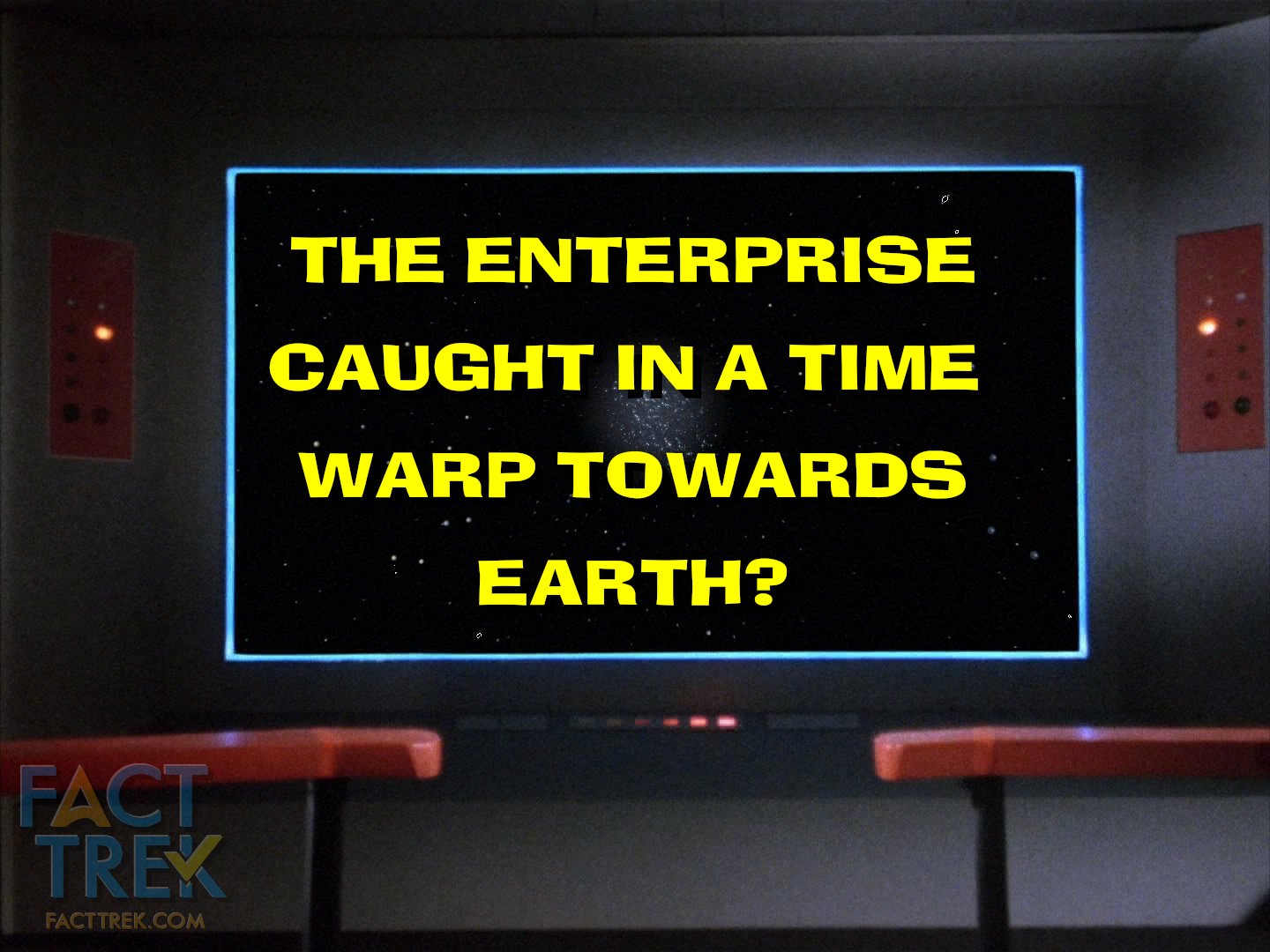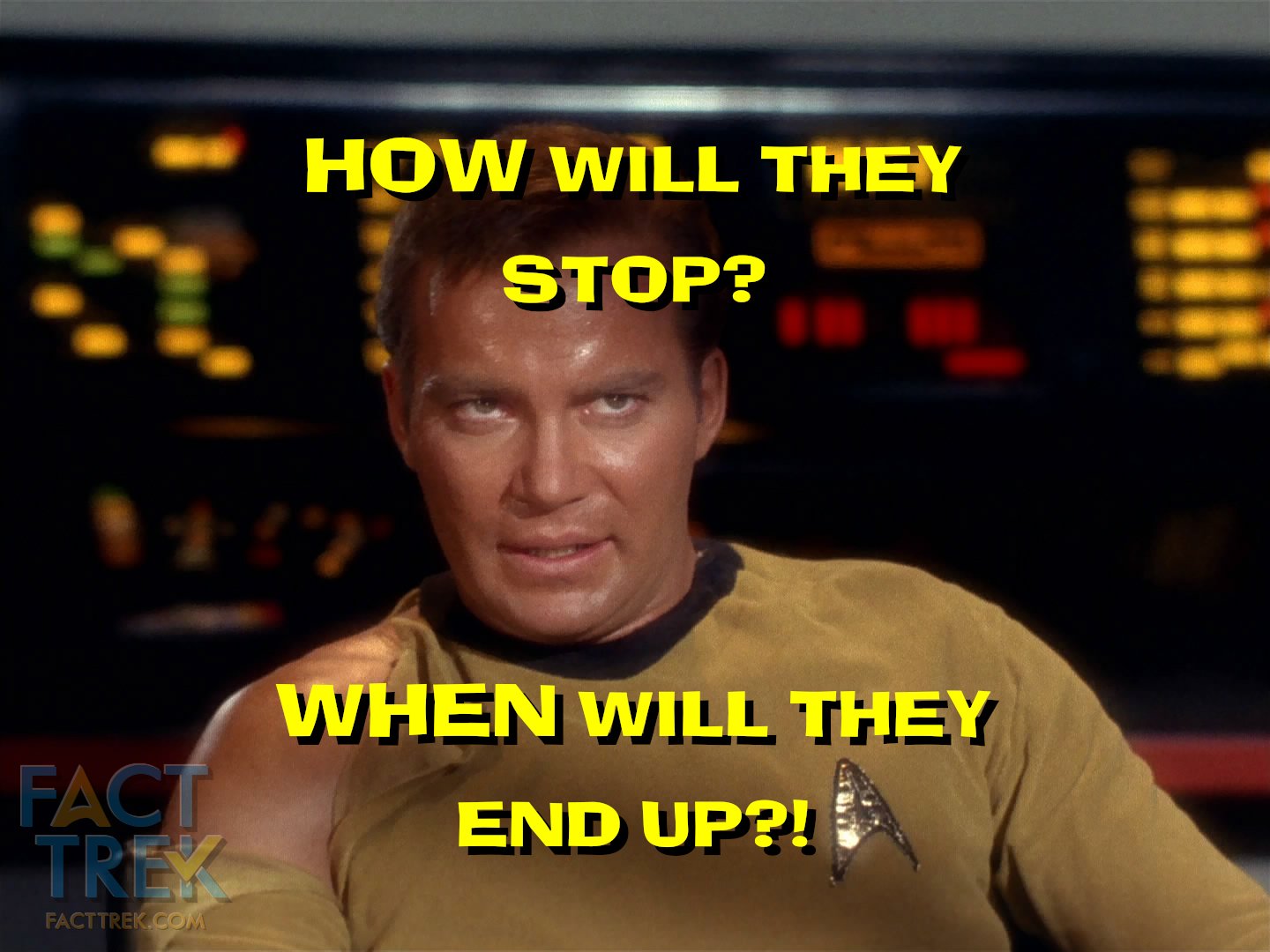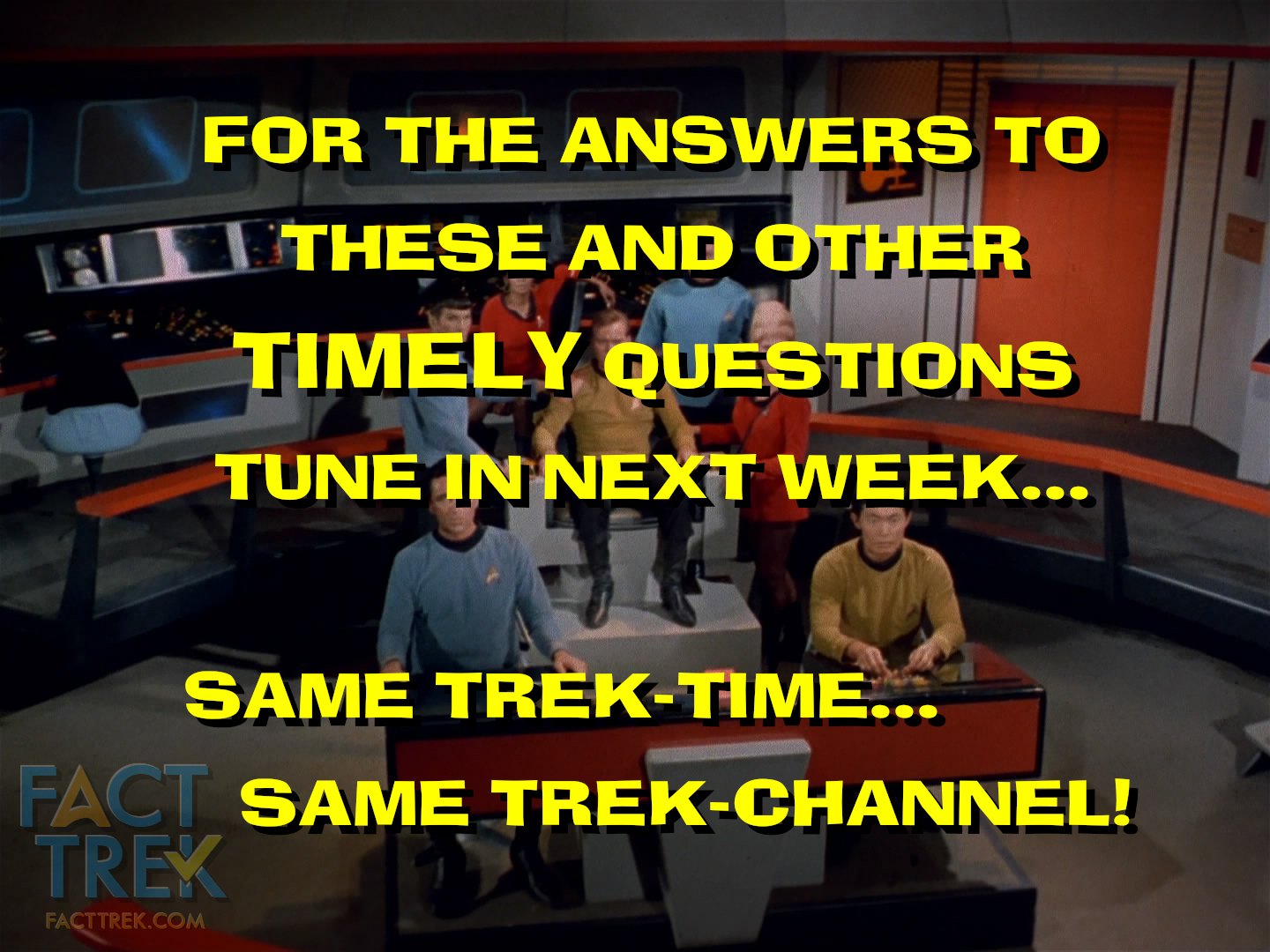The Naked Cliffhanger
“The Naked Time” is an all-time classic Star Trek episode memorable for characters going berserk and revealing their “naked” psyches, notably shirtless Sulu with a fencing foil, Spock breaking down over the emotions he struggles to keep in check, and Kirk’s obsession with the Enterprise. The episode ends with a “laws of physics” defying bang as the starship restarts her engines cold in an “implosion” and is hurled into a time warp, ending—as Spock observes—in the recent past.
We have regressed in time seventy-one hours ... It is now three days ago, Captain. We have three days to live over again.SPOCK
But a redo didn’t just happen on the screen. It happened in the production of the episode.
On the afternoon and early evening of Thursday, July 7th, 1966, on Stage 9 at Desilu Gower in Hollywood, the closing scenes of “The Naked Time” went before the cameras.
By the end of that day, the company had completed 32 setups and printed 3,950 feet of film—more printed footage than any other day of the shoot—but the finale filmed on this day would not make it to the air intact.[1]
Six weeks later, in the early evening of Wednesday, August 17th, and just after the wrap of “Dagger of the Mind”, from 5:25–7:00PM, the closing scenes of “The Naked Time” went before the cameras yet again, for the last time…[2] A new ending.
Why did this happen? What was this ending? It's long been said to have been a cliffhanger. Is that true?
Let’s risk an implosion and time warp back 57 years to find out.
First Time Naked Time
There’s a Hollywood aphorism that the show you set out to make isn’t what ends up on screen. This was as true for Star Trek as any other show.
As was and is typical of television production, lines of dialogue and even entire scenes were discarded for various reasons during editing. Episodes would run long and need to be tightened to meet NBC’s time slot constraints. Moments that seemed to work on the page might fall flat on film. Expensive opticals might be trimmed to save the budget. And so on.
FACT TREK Note: If you’re further interested in the subject, we highly recommend Star Trek: Lost Scenes (link) by David Tilotta and Curt McAloney.
The endings of several episodes were altered between stage and screen. Notably the deletion of Kirk and his nephew on the bridge at the end of “Operation—Annihilate!”, the snipping of Lt. Palamas’ pregnancy at the close of “Who Mourns for Adonais?”, and the excision of Kang and Mara on the bridge of the Enterprise in the tag of “Day of the Dove”.
From the deleted scene at the end of “Operation—Annihilate!”
What sets “The Naked Time” apart from every other episode of Star Trek is why this scene wasn’t used. It wasn’t merely trimmed. It was scripted and filmed as a cliffhanger, then parts of it were scrapped, rescripted and reshot.
No Cliffs, No Hangers
“The Naked Time” didn’t start out with a cliffhanger. The Roddenberry papers at UCLA contain Black’s story outline (undated, but per other documents, written on or before April 4th[3]) and a June 14th dated “Preliminary Draft”, both of which end the story on an unambiguous note. The Enterprise’s escape from the planet doesn’t involve mixing matter and antimatter cold or an implosion...let alone feature Scotty’s classic “I can’t change the laws of physics” line. They retake the engine room, activate the engines, and…well what happens next is wacko (and we’ll discuss in a future article), but the ship escapes the planet in the nick of, er, time, minus any hint of time warping shenanigans.[4]
What’s also important at this juncture is that although the disease of the week is still acting on the crew as the Enterprise escapes Psi 2000, it conveniently ceases to be a problem for the tag. Here, from the “preliminary draft” is McCoy’s summation:
McCoy A virus...lasts twenty-four hours and dies...a cold lasts a bit longer...one symptom...a moist- ness on the palms of your hands ...is communicated by physical contact...no explanation and no cure...but it affects the afflicted like a quart of bourbon...lets out everything you try to keep hidden.
Poor Bones didn’t even get to save the day. As in H.G. Wells’ The War of the Worlds, the threat died by dint of Deus Ex Machina.
FACT TREK Note:Colorful Covers & Colorful Pages
Before proceeding, a brief detour into the Hollywood script process is useful.
Scripts in the works did not have covers. Any draft distributed outside the writers and producers would get a color coded cover. On Star Trek first drafts had a canary yellow cover, and were circulated to department heads, series regulars, NBC Broadcast Standards, etc., to get feedback and to allow preliminary planning. (Early in the third season, Roddenberry floated the idea to Justman that the production stop sharing yellow cover drafts with the actors, but it’s unclear if anything came of this proposal.[5].)
“Final Drafts” had a gray cover and were intended to be shooting scripts and were distributed to the entire production. Despite the name, however, these scripts were sometimes completely rewritten, which would result in a “Revised Final Draft” script with a red cover. Any alterations to a gray or red cover script would result in “change pages,” which would replace previous pages or be new pages. Such pages would feature the date of the change in the header and be issued in paper colors other than white—first in blue, then in pink, etc.[6]
Note that Star Trek’s color coding system for script covers was not universal. Even Mannix, which was written and produced at Desilu alongside Star Trek, did not follow the same system, opting instead for yellow covers for first drafts, pink covers for final drafts, and orange covers for revised final drafts.[7]
Heading For the Cliff
At this early stage Star Trek hadn’t yet done a two-part anything, and ultimately would only do it once with “The Menagerie.” Cliffhangers weren’t unknown on TV at the time. Lost In Space ended its first and second season episodes on cliffhangers, but—outside of the first six episodes—these were simple gimmicks restricted to the tag and teaser to vaguely connect unrelated stories and keep viewers tuning in. Space employed only one true two-parter, “The Keeper”, which was one story split over two episodes, much like an episode of Batman. (The Time Tunnel would likewise employ cliffhangers when it premiered, but in the vein of Lost In Space.)
As above “The Naked Time” was originally outlined and “Preliminary Draft”’ed as a typical self-contained episode. But this abruptly changed with what the script reports identify as the yellow-cover “First Draft” dated Thursday, June 23rd, 1966. In it, the disease neither self-resolves nor does McCoy concoct a cure. With Kirk fully in the throes of the infection, the Enterprise fires all her power units simultaneously and is hurled away from the planet and into a time warp from which it does not escape before the fade out. It concluded:
And Kirk bursts out of his chair... fury unbridled now... control gone... and his eyes rake across the room... the equipment... the goddam ship... the beautiful ship... the captain’s life... the goddam life!!!And the energy of his words sweep him to Spock...then his eyes are drawn to Spock's console...and he whirls...Never lose you... never... never... didn’t explode..!KIRK(at it - to it - a consummation of this marriage)(at Janice - softly - suddenly)No beach to walk on... never... no sound of waves running...(at the ship)Never lose you...EXT. SPACE The stars seeming to distort... bunch... compress... and over it...Faster than light...we're going faster than light...faster than time...KIRK(voice building)FADE OUT END OF PART ONE THE NAKED TIMEFaster than light... faster than time... faster than man has ever gone Before!!!!!KIRK'S VOICE
From yellow cover script (FIRST DRAFT, June 23, 1966). Sc. 132 (p.67)
And with this draft something new has been added: “PART I” appears on the title page and “END OF PART ONE” on the final page.
This is a literal cliffhanger. The only thing that’s been resolved is the ship escaping the planet, but it has leapt out of the frying pan into the fire.
Shot from the originally filmed ending, perhaps just as the Navigator says, “You asked for "Earth, sir.” Image courtesy David Tilotta of Star Trek Lost Scenes.
Likewise, the June 28th, 1966 Final Draft’s gray cover and subsequent title page both feature “(PART I)” and the final page concludes with “END PART ONE”.
The revised story likewise ends with the ship caught in a time warp. This time Bones has found a cure and shoots Kirk up, eliminating the loose end of the disease. But now Scotty mixes matter and antimatter cold, precipitating the time warp and adding the wrinkle that the ship is heading towards Earth… slowing, but when will it be when it stops in Part Two?
EMPHASIZING KIRK Turning, a quick glance at McCoy, then Spock.Begin reversing power, helm. Slowly.KIRK(continuing)Helm answering, sir. Power reversing.SULU(adjusts controls)Course?SPOCK(to Kirk)Course, Navigator?KIRKYou asked for "Earth", sir.NAVIGATORAs they eye the viewing screen, uncertain, waiting:Earth, then. Steady as we go.KIRK(considers it; nods)
FADE OUT. END PART ONE
Shooting Script (FINAL DRAFT, June 28, 1966). Sc. 125 (p. 61-62)
This last-minute unresolved cliffhanger appears to have been exactly what was filmed. The July 1st and 5th change pages (revisions) were delivered as the show was shooting, but none of those pages altered the ending. The daily production reports support that this open-ended time warp ending was filmed.
But as we all know, that’s not the ending that aired…because A Funny Thing Happened On the Way To the Airdate.
The official drafts of the script as spelled out in an August 28th, 1966 script library memo. It does not cover “working” drafts that did not go through mimeo.
FACT TREK Note: "Mimeo" refers to a mimeograph; a low-cost duplicating machine with an ink roller which required a typed up “master” stencil for each page. Although xerography / photocopying existed at this time, it was expensive and generally not used for large documents with large distribution lists.
Backing Away From the Cliff
Principal photography on the episode initially wrapped on July 11th, and the Episode Status Reports on July 18th, 25th, and August 1st list its status as “Principal Photography completed. Editing” with the lattermost including the note “Will screen First Cut 8/4/66” (August 4th).[8]
But one week after the First Cut was screened, on August 11th—and a month after principal photography wrapped—a whole new ending came out of mimeo. The header for all four of these new blue pages read “NEW ENDING - 8/11/66”, which makes plain this was no minor tweak. The changed material constitutes approximately 2¼ pages, or about 100 seconds worth of material, scripted to intercut with some of the material shot previously and stock footage. This climax is the one that aired: the Enterprise is flung into a time warp from which they exit three days into the past. These change pages close the story with a conclusive END TITLE, and no suggestion of a follow-up.
Then, in the early evening of Wednesday, August 17th, just after the wrap of “Dagger of the Mind”, parts of the closing scenes of “The Naked Time” went before the cameras yet again, and for the last time.[9] (These scenes were almost certainly directed by Vincent McEveety and not Marc Daniels, who otherwise directed the rest of "The Naked Time".)
There’s no mention of this new filming in the subsequent Episode Status Reports. The August 8th, 15th, 23rd, and 29th ones all list the episode as “Principal Photography completed. Editing” before finally switching to “Principal Photography completed. Dubbing” in the September 6th report.[10] However, it is accounted for in the production budgets dated 1966-11-12 and 1967-1-20.[11]
FACT TREK Note: You can easily spot the new material because only Shatner and Nimoy were on set for these pickups, so it’s largely closeups of them, concerned with the realization that they can go back through time, and that Kirk would rather not relive those last three days. Any shots including other characters on the bridge were from the original ending’s shoot or stock footage (like Sulu at the helm).
Going Off the Cliff
So, somewhere on the road to a cliffhanger, “The Naked Time” went off a cliff. In summation:
“The Naked Time” was outlined, approved for script, and initially drafted as a stand-alone episode.
Somewhere between the Preliminary Draft and First Draft, a decision was made to make “The Naked Time” part one of a two-parter.
The episode was filmed with an open-ended finale wherein the ship was in a time warp on course towards Earth.
A little over a month later, and days after screening a first cut, a new ending was written, which scrapped the cliffhanger and the idea of a part two.
The following week the new ending was filmed.
But the 64,000 credit question is why was a cliffhanger added in the first place? A cliffhanger was an aberration for Star Trek. Why did Black add it? Why did Roddenberry keep it? Why did they film it? And just why did they scrap it?
Unfortunately, the Roddenberry Papers at UCLA don’t appear to contain the answers. The finding aid for one of the folders for “The Naked Time” contains the note “Includes correspondence regarding or with: * Black, John D.F.” But no such correspondence is found, so no firm answers there. We checked interviews with Black and articles he and his wife—Mary Black—wrote about their time on Star Trek. We looked high and low and were unable to find any answer.
What it left us with were more questions. Who films a Part One without a Part Two in the pipeline? Who was supposed to write this follow-up? And just what was this prospective second part to be?
“Tomorrow is Yesterday!” we hear some of you cry.
But, as ever, we ask, “Is it true?”
Tune in to Part Two for the answer.
FADE OUT
END OF PART ONE
THE NAKED CLIFFHANGER
P.S. And, unlike “The Naked Time” there will be a part two: The Naked Time Warp.
—30—
Acknowledgements
Huge thanks to FACT TREK Associate David Tilotta for his invaluable assistance in sorting out the various rough and mimeoed drafts of the script, providing photos and images of documents, critiquing, and generally being a mensch. Consider him a co-author of this piece, cuz we do. Buy his and Curt McAloney’s terrific book Star Trek Lost Scenes here (link).
Special thanks to FACT TREK Research Fellow Sgt. Bilko for providing us with a scan of the complete gray cover June 28 [revised] final draft of the script. May the Great Bird of the Galaxy roost upon your planet.
Grande grazie a Marcello Rossi for sending us scans of the articles by John D.F. and Mary Black wrote for Star Trek The Magazine (from a never-published memoir) to make sure we hadn’t overlooked any comments they might’ve made about the episode.
Trekcore, for the screenshots from the episode.
And thanks as always to FACT TREK Associate Ryan Thomas Riddle for applying his editorial superpowers to this article. Follow his adventures through time and space on Twitter (link) and see his work on his homepage (link).
See Also
End Notes & Sources
[1] “The Naked Time” Daily Production Report, July 7, 1966, UCLA, Gene Roddenberry Star Trek television series collection, 1966–1969.
[2] “Dagger of the Mind” Daily Production Report, August 17, 1966, UCLA, Gene Roddenberry Star Trek television series collection, 1966–1969.
[3] Writer Reports, memos, and status reports. UCLA, Gene Roddenberry Star Trek television series collection, 1966–1969.
[4] “The Naked Time, outlines and teleplays. UCLA, Gene Roddenberry Star Trek television series collection, 1966–1969.
[5] 1968-05-14 memo from Gene Roddenberry to Bob Justman floating the idea of rescinding the policy of sending Yellow cover scripts to actors. UCLA, Gene Roddenberry Star Trek television series collection, 1966–1969.
[6] 1966-10-06 Letter from Gene Roddenberry to Linwood Dunn re first draft script of The Menagerie two-parter, explaining the color coded cover and page revision system for scripts. UCLA, Gene Roddenberry Star Trek television series collection, 1966–1969.
[7] Mannix Television Script Collection, Heritage Auctions, Sold November 7, 2009.
[8] Episode Status reports, July–August 1966. UCLA, Gene Roddenberry Star Trek television series collection, 1966–1969.
[9] “Dagger of the Mind” Daily Production Report, August 17, 1966, UCLA, Gene Roddenberry Star Trek television series collection, 1966–1969.
[10] Episode Status reports, August–September 1966. UCLA, Gene Roddenberry Star Trek television series collection, 1966–1969.
[11] Production Budgets and/or Cost Reports for “The Naked Time”, November 12, 1966 and January 20, 1967. UCLA, Gene Roddenberry Star Trek television series collection, 1966–1969.
Anything to show some skin…






